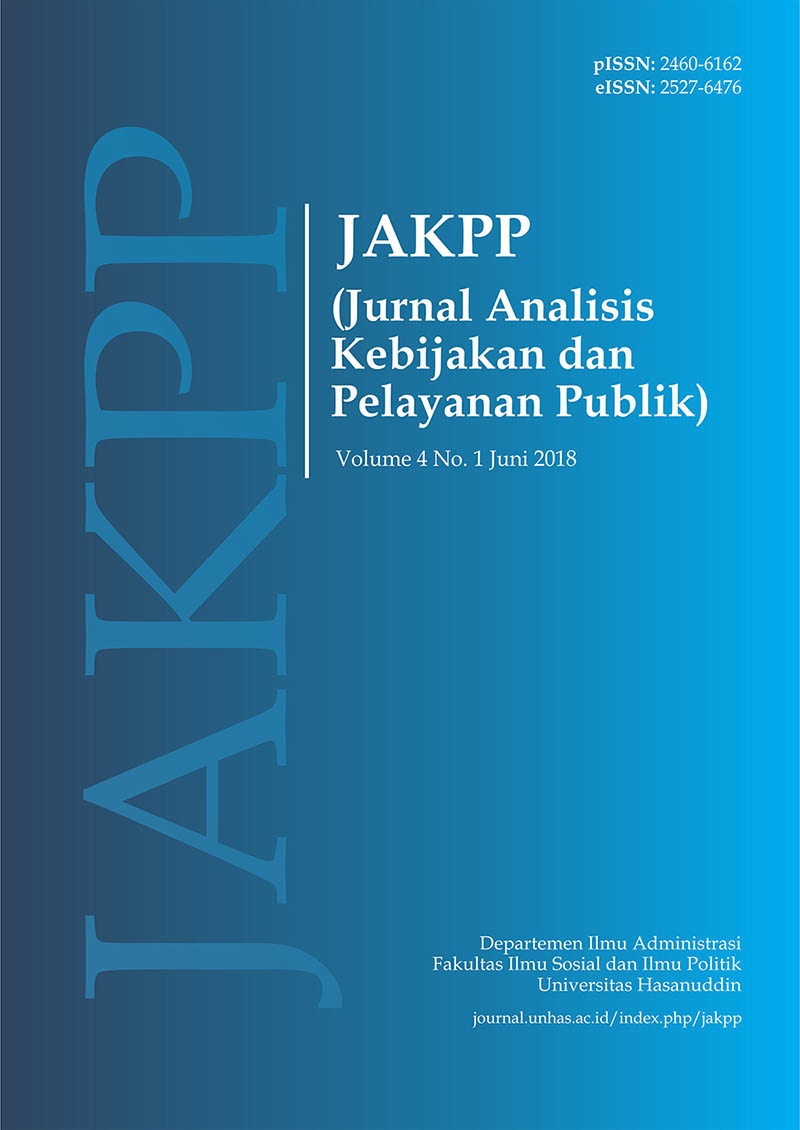Reformasi Birokrasi di Indonesia: Tinjauan Dari Perspektif Administrasi Publik
DOI:
https://doi.org/10.31947/jakpp.v4i1.5902Keywords:
Keywords, Reform, Bureaucratic Reform, Public Administration Perspective Kata kunci, Peningkatan Pelayanan Kesehatan, Puskesmas, Pencegahan, Demam Berdarah DengueAbstract
This article aimed to describe the model of bureaucratic reform that has been done, both in Indonesia, and other countries in the world. This is important to provide a comprehensive understanding of the importance of bureaucratic reform form the Public Administration perspective. The research method used in this paper was literature review obtained from various sources related to bureaucracy reform. The results of this literature review illustrates that the reform of bureaucracy ever done in some countries commonly when related to two dimensions of organizational Human Resources (HR) dimensions. Organizational dimension is related to structure, organizational culture, organizational technology, law and regulation. The HR dimension of the apparatus includes knowledge, skills, attitudes, behaviors, mindset, discipline, integrity, performance. Bureaucracy reforms conducted in various countries such as in the United States during the reign of President Bill Clinton known as reinventing government which asserts that to improve the administration of government, it is necessary to transform the values of entrepreneurship into the administration. In Europe, it is known as Neo-Weberian State (NWS) which essentially strengthens the State's role in bureaucratic service with the principle of prioritizing citizenstate relations to fulfill citizen's basic rights. Similarly, reforms are undertaken in African Commonwealth countries that emphasize the importance of bringing about transparent and accountable governments. In Indonesia, bureaucratic reform has been conducted since 1998 with aiming of producing a clean bureaucracy from corruption, collusion and nepotism (CCN). The embodiment of those objectives is stipulated through Regulation of the Minister of Administrative and Bureaucracy Reform Number 11 year 2015 regarding the road map of bureaucratic reform from 2015 to 2019. However, the implementation of these regulations has not succeeded yet in creating a professional, clean and accountable bureaucracy, and performs well.References
Anonim. (2016). Area Perubahan Reformasi Birokrasi 2015-2019. http://pemerintah.net/area-perubahan-reformasi-birokrasi-2015-2019/. Diakses pada 20 Maret 2018.
Commonweath Secretariat (2016) Key Principles of Public Sector Reforms : Case Studies and Frameworks, The Coommonweath Secretariat, London, UK.
Dwiyanto, Agus (2011) Mengembalikan Kepercayaan Publik Melalui Reformasi Birokrasi. Jakarta: PT Gramedia Pustaka Utama.
Dwiyanto, Agus, et al. (2002) Reformasi Birokrasi Publik di Indonesia. Yogyakarta: Pusat Studi Kependudukan dan Kebijakan UGM.
Girindrawardana, D. (2002) Public Services Reform in Indonesia. Ombudsman Indonesia, Jakarta.
Haning, M. Thahir (2015) Reformasi Birokrasi: Desain Organisasi yang Mendukung Pelayanan Publik di Indonesia. Yogyakarta: Ilmu Giri.
Horhoruw, M. et al. (2012) Transforming the Public Sector in Indonesia: Delivering Total Reformasi. World Bank Publication. (March), 1–14. [online]. Available from: http://siteresources.worldbank.org/EXTGOVANTICORR/Resources/3035863-1289428746337/Transforming_Public_Sector_Indonesia.pdf.
Mungiu-Pippidi et al. (2017) Index of Public Integrity [online]. Available from: http://integrity-index.org/ (Accessed 5 March 2018).
Ndue, P. N. (2005) Democratization, Good Governance and Administration Reform in Africa. The Enabling State and the Role of the Public Service in Wealth Creation: Problems and Strategies for Development in Africa. [online]. Available from: http://unpan1.un.org/intradoc/groups/public/documents/AAPAM/UNPAN025713.pdf.
Osborne D and Gaebler. (1992) Reinventing Government: How the entrepreneurial spirit is transforming the public sector. Plume Publisher, USA.
Pollitt, C. & Bouckaert, G. (2011) Public Management Reform: A Comparative Analysis—New Public Management, Governance, and the Neo-Weberian State. [Online].
Rasul, I. & Rogger, D. (2017) Management of Bureaucrats and Public Service Delivery: Evidence from the Nigerian Civil Service. Economic Journal. [Online] 128413–446.
Sheng, Y. K. (2009) What is Good Governance ? United Nations Economic and social Comission for Asia and the Pacific [online]. Available from: http://www.unescap.org/. [online]. Available from: http://www.unescap.org/.
Thoha, M. (2012) Government Bureaucracy and the Power in Indonesia (Birokrasi Pemerintah dan Kekuasaan di Indonesia). Suraji (ed.). Yogyakarta: Matapena Institute.
UN (1997) Administrative reforms: Country profiles of five Asian countries. United Nations Department of Economic and Social Affairs [online]. Available from: http://en.baomoi.com/Info/Administrative-reforms-succeed/3/153357.epi. [online]. Available from: http://en.baomoi.com/Info/Administrative-reforms-succeed/3/153357.epi.
Wong, W. (2013) The Search for a Model of Public Administraition Reform in Hong Kong: Weberian Bureaucracy, New Public Manahemen or Something Else? Public Administration and Development. [Online] 33297–310.
Downloads
Published
Issue
Section
Accepted 2019-01-12
Published 2019-01-12







